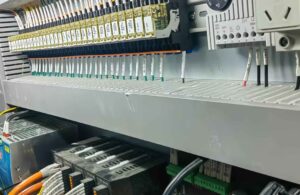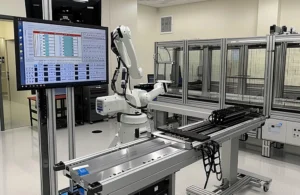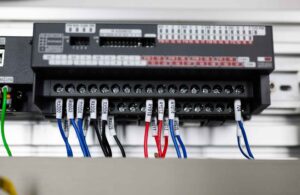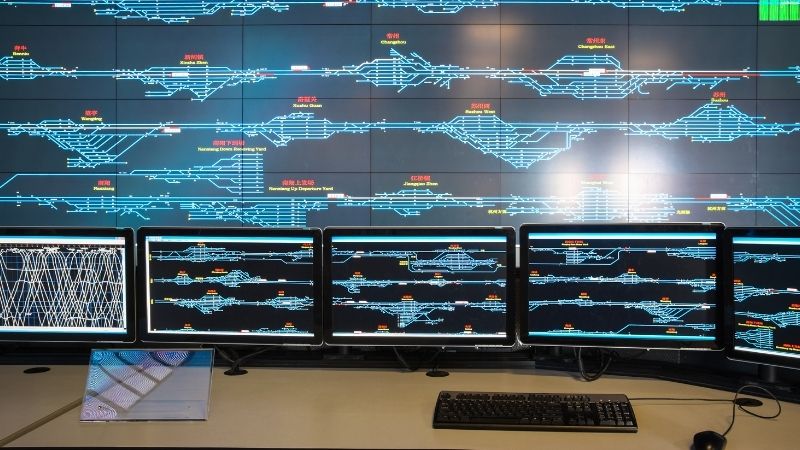HMI lwn. SCADA: Panduan Penting untuk Automasi Industri
Blog ini menyelami aspek teras HMI dan sistem SCADA, komponen, aplikasi dan faedah yang mereka bawa kepada industri moden.
Jadual Kandungan
Apakah SCADA dan Bagaimana Ia Berfungsi?
SCADA, singkatan untuk Kawalan Penyeliaan dan Pemerolehan Data, ialah sistem terpusat yang direka untuk memantau dan mengawal proses perindustrian. Menggabungkan perkakasan dan perisian, SCADA membolehkan industri mengumpul data masa nyata daripada penderia, menghantarnya ke sistem kawalan dan memberikan cerapan yang boleh diambil tindakan.
Ciri-ciri Utama Sistem SCADA:
- Pengumpulan Data: SCADA mengumpulkan maklumat daripada penderia dan menghantarnya ke hab kawalan pusat.
- Pemantauan dan Makluman: Ia mengesan penyelewengan atau kegagalan dan menghantar makluman masa nyata.
- Automasi: Sistem ini mengautomasikan tugas rutin, mengurangkan keperluan untuk campur tangan manual.
- Kawalan Jauh: Operator boleh mengawal peralatan dan proses dari lokasi terpusat atau terpencil.
Industri Memanfaatkan SCADA:
Sistem SCADA mencari aplikasi merentas pelbagai sektor, termasuk:
- Minyak dan Gas
- Rawatan Air
- Pembuatan
- Pengagihan Tenaga
- Pengangkutan
Memahami HMI: Gerbang Operator
Antaramuka Manusia-Mesin (HMI) berfungsi sebagai medium visual dan interaktif antara pengendali dan sistem kawalan industri. Daripada skrin sentuh kepada peranti mudah alih, sistem HMI membenarkan pengendali memantau dan mengawal proses dengan lancar.
Komponen Sistem HMI:
- Perkakasan: Termasuk peranti input (skrin sentuh, butang) dan peranti output (monitor, penunjuk).
- Perisian: Menyediakan antara muka pengguna untuk mengawal proses dan menganalisis data.
- Protokol Komunikasi: Memudahkan pertukaran data antara mesin dan pengendali melalui Modbus, Ethernet/IP atau rangkaian wayarles.
Aplikasi Sistem HMI:
- Memantau barisan pengeluaran dalam pembuatan
- Mengawal aliran tenaga dalam grid pintar
- Mengurus sistem HVAC dalam bangunan pintar
- Menyelia proses rawatan air sisa
Hubungan Antara HMI dan SCADA
Walaupun HMI dan SCADA berkait rapat, ia mempunyai tujuan yang berbeza dalam automasi industri:
- HMI sebagai Komponen SCADA: HMI menyediakan antara muka mesra pengguna untuk berinteraksi dengan sistem SCADA.
- SCADA sebagai Sistem Pusat: SCADA mengurus dan mengawal operasi yang kompleks, manakala HMI bertindak sebagai alat visualisasi pengendali.
- Bersama-sama, mereka memastikan aliran data yang lancar, cerapan yang boleh diambil tindakan dan kawalan proses yang cekap.
Faedah Mengintegrasikan HMI dan SCADA
Penyepaduan HMI dan SCADA menawarkan kelebihan yang tiada tandingan kepada automasi industri:
- Peningkatan Kecekapan: Memperkemas operasi dengan pemantauan masa nyata dan analisis data.
- Keselamatan yang Dipertingkatkan: Memberi amaran kepada pengendali tentang potensi bahaya, mengurangkan risiko.
- Pengoptimuman Kos: Automasi meminimumkan kos operasi dan masa henti.
- Kebolehskalaan: Mudah disesuaikan dengan keperluan industri yang semakin berkembang.
- Kebolehcapaian Jauh: Membolehkan pengendali memantau sistem dari mana-mana sahaja.
Komponen Teras Sistem SCADA
Untuk berfungsi dengan berkesan, sistem SCADA bergantung pada empat komponen utama:
- Penderia: Ukur parameter seperti suhu, tekanan dan kadar aliran.
- Unit Penukaran Data: guna PLC dan RTU untuk memproses data sensor mentah.
- Papan Pemuka HMI: Bentangkan data dalam format yang boleh difahami untuk pengendali.
- Rangkaian Komunikasi: Sambungkan komponen di seluruh kemudahan menggunakan kaedah berwayar atau tanpa wayar.
Aliran Masa Depan dalam HMI dan SCADA
Apabila industri berkembang, sistem HMI dan SCADA mengguna pakai teknologi canggih untuk meningkatkan fungsi:
- Integrasi IoT: Menyambung peranti untuk pengumpulan dan analisis data yang lebih bijak.
- AI dan Pembelajaran Mesin: Analitik ramalan untuk penyelenggaraan dan pengoptimuman proses.
- Pengkomputeran Awan: Storan data terpusat dan kebolehcapaian jauh.
- Antara Muka Pengguna yang Dipertingkatkan: Reka bentuk HMI yang lebih intuitif dan boleh disesuaikan untuk pengalaman pengguna yang lebih baik.
Kuasakan projek anda dengan Omron, Mitsubishi, Schneider HMI yang baharu dan asli – dalam stok, sedia sekarang!
Kesimpulan
Sistem HMI dan SCADA adalah alat yang sangat diperlukan dalam automasi industri, bekerja secara harmoni untuk memantau, mengawal dan mengoptimumkan proses yang kompleks. Walaupun SCADA menyediakan platform terpusat untuk mengurus operasi, HMI merapatkan jurang antara mesin dan pengendali manusia. Bersama-sama, teknologi ini membolehkan industri mencapai kecekapan, keselamatan dan produktiviti yang lebih tinggi.
Jika anda memerlukan pembekal HMI, hubungi Kwoco. Kami menawarkan HMI yang baru dan asli daripada Proface, Omron, dan Mitsubishi, sedia untuk penghantaran ke seluruh dunia. Kualiti yang boleh dipercayai, jenama yang dipercayai dan perkhidmatan global menanti anda!
Hubungi Kami
Cuma isi nama, alamat e-mel dan penerangan ringkas tentang pertanyaan anda dalam borang ini. Kami akan menghubungi anda dalam masa 24 jam.
Anda Juga Mungkin Mendapatkan Topik Ini Menarik

Panduan Komprehensif untuk Jenis Sensor Fotoelektrik dalam Automasi Perindustrian
Artikel ini menyelidiki dunia penderia fotoelektrik yang menarik, meneroka pelbagai jenis, fungsi dan aplikasinya dalam automasi industri. Kami berhasrat untuk memberikan pemahaman yang komprehensif tentang cara pengesan ini mengubah proses pembuatan, meningkatkan kecekapan dan memastikan ketepatan. Jika anda terlibat dalam industri mesin dan peralatan, pembuatan atau menyediakan penyelesaian kilang, artikel ini menawarkan pandangan berharga tentang memanfaatkan teknologi penderia fotoelektrik untuk operasi anda, dan ia menerangkan sebab membaca lebih lanjut akan melengkapkan anda dengan pengetahuan untuk mengoptimumkan strategi automasi anda .

Memahami HMI: Apa Itu dan Bagaimana Ia Berfungsi
Dalam automasi industri, HMI (Antara Muka Manusia-Mesin) ialah istilah biasa. Tetapi apa sebenarnya ia, dan apa yang dilakukannya? Sebagai jurutera di Kwoco, saya bekerja dengan sistem HMI setiap hari, dan hari ini, saya akan membawa anda melihat secara mendalam.

Raspberry Pi sebagai Pengawal PLC: Logik Boleh Aturcara Dijelajahi
Ketahui cara Raspberry Pi mengubah pengawal logik boleh atur cara dan maksudnya untuk automasi industri.






